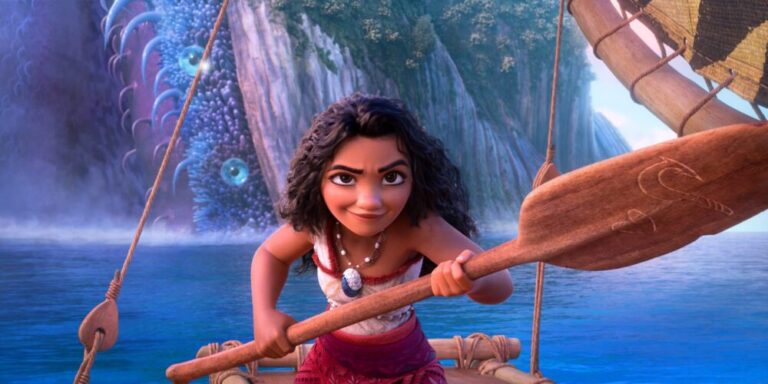Years after her original journey to restore the heart of Tafiti, Moana returns to embark on an adventure going further than ever before. She finds herself with no choice but to follow the call of her ancestors and unite the people of Oceania. However, this requires Moana to take the risk of leaving her people behind forever due to the dangerous path ahead. Dwayne Johnson and Auli’i Cravalho reprise their respective roles as Maui and Moana, accompanied by a range of new characters that bring their own unique flair to the story.
One new character is Moana’s little sister Simea, who is a heartwarming addition to the cast and serves as a motivation for the heroine to make it back to the island. Other new faces range from members of Moana’s crew across the sea to a few new villains. A new antagonist, Matanagi, provides an interesting dynamic with Moana as well as a great musical number.
However, the loss of musical director Lin-Manuel Miranda is clearly felt throughout each of the sequel’s songs. It seems as though the new team is trying their best to emulate Miranda’s classic style, but falls short. This is not to say that the songs were wholly unenjoyable, though. The clear highlight of the soundtrack is “Beyond,” the film’s “I Want” song, in which Moana sings about the new journey she faces. Auli’i Cravalho shines through her vocal performance, conveying her desire to go further in life while hesitating to leave the past behind. One of the film’s biggest disappointments was The Rock’s vocal performance on Maui’s song, “Can I Get a Chee Hoo?” The song feels like the poor man’s “You’re Welcome” and fails to deliver the same energetic, fast-paced rap that Lin-Manuel Miranda is known for.
Although its plot is simple, the film suffers from leaving major plot points unresolved. For example, Moana experiences a great character change near the final act that affects her both physically and mentally. However, the film never attempts to explain the significance of this change regarding Moana’s new role in the story. Additionally, the fate of a newly introduced character is left entirely up to the viewer’s interpretation.
The film’s development is very interesting in and of itself, being animated at Disney’s Vancouver studio. Originally, the film was intended to be a Disney+ TV series, which is fairly obvious given the strange pacing and introduction of underutilized side characters. The studio was notified of an intended theatrical release in February, leaving them only eight months to rework the story, songs and visuals before the deadline. This tight deadline was a major contributor to the stiff animation, an issue that is not overtly obvious but can be spotted when looking for it.
Despite its shortcomings, the film is easily enjoyable and nostalgic for many audiences. There is a palpable respect for Polynesian and Oceanic culture, and it is clear that the team put a lot of thought into meaningful ways to incorporate these elements. Moana’s journey and character growth feel like natural continuations of the first film while breaking the mold for the Disney Princess archetype.
